Hiking boots: What you need to know
You’ll definitely want hiking boots that give you a secure grip. No blisters on your feet and a comfortable boot interior would also be nice. These are the things you need to watch out for when buying hiking boots – here’s an overview for you.
Hiking boot material
You will often wear hiking or trekking boots on your feet for hours at a time during strenuous activity. That’s why the fit of the boots should match your feet as closely as possible. It depends on the material as to how well hiking boots will adapt to your feet, and how hot or cold your feet will get also depends on the material. Depending on the material, the fit or the temperature inside the shoes will be different. It’s important to look at the inner and outer materials separately. All-leather footwear has different specs to hiking boots where, for example, the outer material is leather but the inner lining has a GORE-TEX® membrane. The membrane has a warming effect. This is an advantage in cold, wet weather. It’s different with a hiking boot where the outer and inner material is leather. This keeps your feet at a pleasant temperature on warm, dry days.
The following overview outlines the features associated with the materials.
Hiking boots made of leather, inner and outer material
Adapt themselves slightly better to the feet
Moisture is wicked away well, ensuring a pleasant foot environment
Dry quite slowly
Not waterproof, but if well cared for (e.g. with wax) they are very water-repellent
Different types of leather also have different properties. Nubuck leather, for example, which is roughened on the surface resulting in velvety softness, is very tear- and abrasion-resistant. Velour/suede, on the other hand, is smoother, but not as durable.
Hiking boots with leather or textile upper material, GORE-TEX® lining
Often lighter than all-leather boots
Waterproof
Dry faster
Moisture can’t escape as easily due to the GORE-TEX® membrane. This leads to warmer temperatures for the feet.
So before you buy, think carefully about what you need your footwear for, what your requirements are and which material will best satisfy them.
SolesSoles
Vibram soles, which you can recognise from the yellow octagonal logo in the sole, are made of a special rubber compound. This ensures good grip on a variety of surfaces.
Some hiking boots have such stiff soles that you can hardly bend them. This is important for steep mountain terrain, because it gives you a secure grip on small ledges. For easier hikes, the soles should be softer and allow you to roll your foot from heel to toe more easily.
Also, if a boot’s sole wears out at some stage, you don’t necessarily have to throw the boots away. Models that can be re-soled – after being repaired, they’re almost as good as new again.
Caring for hiking and trekking bootsCaring for hiking and trekking boots
With the right care, your hiking boots will last longer. It is important, for example, that you clean them after every hike. The best way to do this is to remove the laces. Then let them dry well – in the air, not in the sun or by a fire. And depending on the material, you can wax or waterproof the boots.
Shoe care
Laces
If your hiking boots or trekking shoes don’t fit, not even the best laces will help. To make the shoes comfortable, it’s essential to wear good functional hiking socks. They create a comfortable shoe interior by absorbing moisture and cushioning the heel and toes.
Before you start lacing, position the tongue centrally on the instep and the lower part of the shin. There should be no creases in the shoe or socks. Then pull the laces – pull hard, but not too hard. On most hiking boots, the first eyelet is a slightly larger, lower one. Thread the laces through this eyelet from top to bottom to form a loop. This fixes the laces and ensures the lacing doesn’t come loose. This is particularly important when walking downhill. It keeps your heels in the back of the shoe and prevents your toes from touching the front. For the following hooks, just thread the laces through from bottom to top, crossing them each time.
SizeSize
Never buy hiking boots that are too small. Sizing differs depending on the brand, but you’ll tend to take a larger size for hiking boots than for everyday shoes. The insole will give you a clue here: remove the insole from the boot and place it on the ground. Then stand on it, with your heel in line with the back of the boot. You should have at least a finger’s width of space (approx. 15 mm) at the front of the boot. This is necessary because your feet slip forwards a little when descending and will also swell when you are hiking. In addition, the foot muscles get tired over time, which causes the arch of the feet to fall and the feet to lengthen.
If your feet are different sizes, test the sole on the bigger foot.
Boot categories SAC scale: T1-T6Boot categories SAC scale: T1-T6
Trekking and hiking boots are available for various activities. Depending on whether you need your boots for short, easy hikes or for long, demanding routes in the mountains, the sole and the height of the upper are the main differences. Here’s an overview for you.
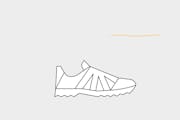
T1 – easy hikes
Use: yellow hiking trails (easy walks in the lowlands)
Surface: paved hiking trails, forest trails, gravel paths
Type of boot: light hiking and trekking boots, soles are soft, shaft does not reach over the ankle
Crampon-compliant: no
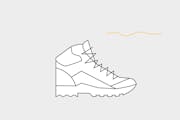
T2 – mountain hiking
Use: white-red-white trails (challenging tours in low mountain ranges, easy trekking tours)
Surfaces: not on paved paths
Type of boot: classic hiking boots also for long tours, usually with a higher shaft
Crampon-compliant: no
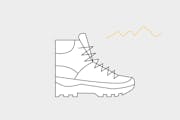
T3 – challenging mountain hiking
Use: white-red-white trails (challenging trekking and hiking tours up to high mountain ranges)
Surface: bad trails, scree, via ferrata, easy glacier tours
Type of boot: sturdy mountaineering boots, ensure a safe grip even when wearing a heavy backpack
Crampon-compliant: suitable for strap-on crampons
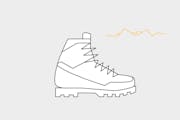
T4/T5 –Alpine hiking/challenging alpine hiking
Use: white-red-white or white-blue-white tours (high mountain ranges, glaciers, harder trekking tours)
Surfaces: glaciers, bad paths, no paths, scree, via ferrata
Type of boot: firm Alpine boots
Crampon-compliant: crampon-compliant under certain conditions
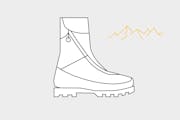
T6 – difficult alpine hiking
Use: unmarked, no paths (high Alpine, glacier, ice and firn tours)
Surfaces: glaciers, ice
Type of boot: crampon-compliant Alpine boots, high shaft and insulated boot
Crampon-compliant: crampon-compliant
Currently not available at Transa.
Finding the right hiking boots – tips
The hiking boots need to fit your feet (tips on shoe size), but it is just as important that they are suitable for the type of adventure you are going on. If you’ll be wearing your boots in very cold areas, they need to be lined, for example. In warm, humid areas, however, it is important that they wick moisture away as reliably as possible and dry more quickly. Before buying, it is therefore essential to consider which conditions you will be wearing the boots in and what types of surfaces you will be walking on.
Do you have any questions?
Get personal advice from our sales advisors in the shops or online and over the phone from customer service. We'll be happy to help you.
- Free shipping from CHF 99
(With the TransaCard always free of charge)
- Secure payment with Twint, Visa and more
- 14 days cancellation right

























